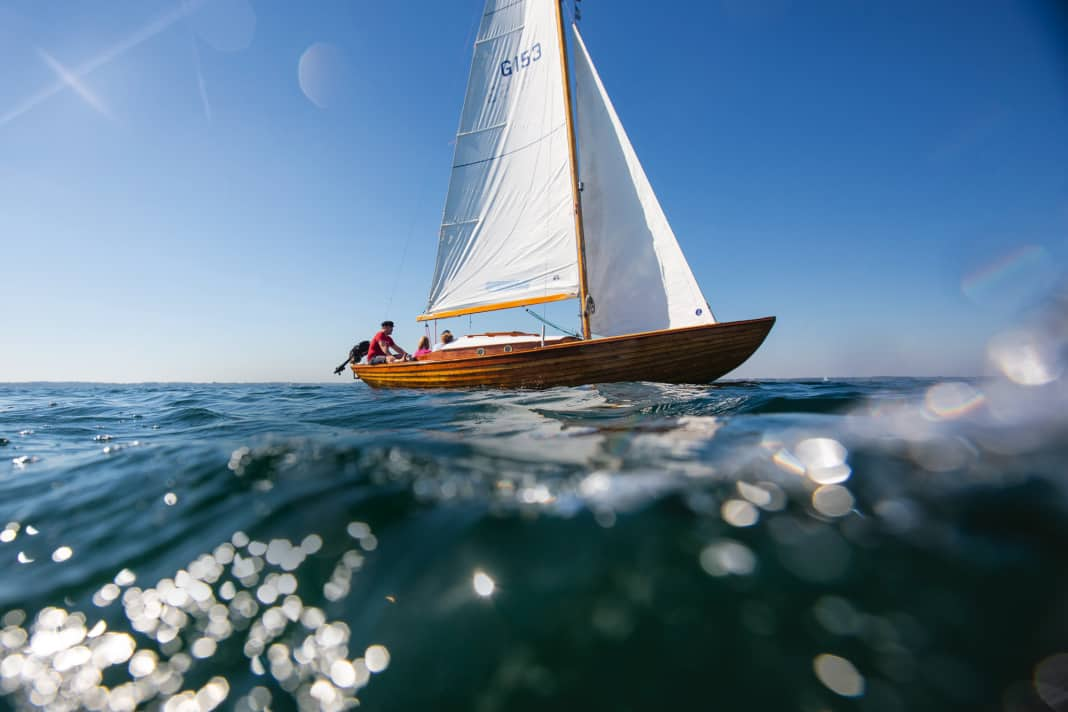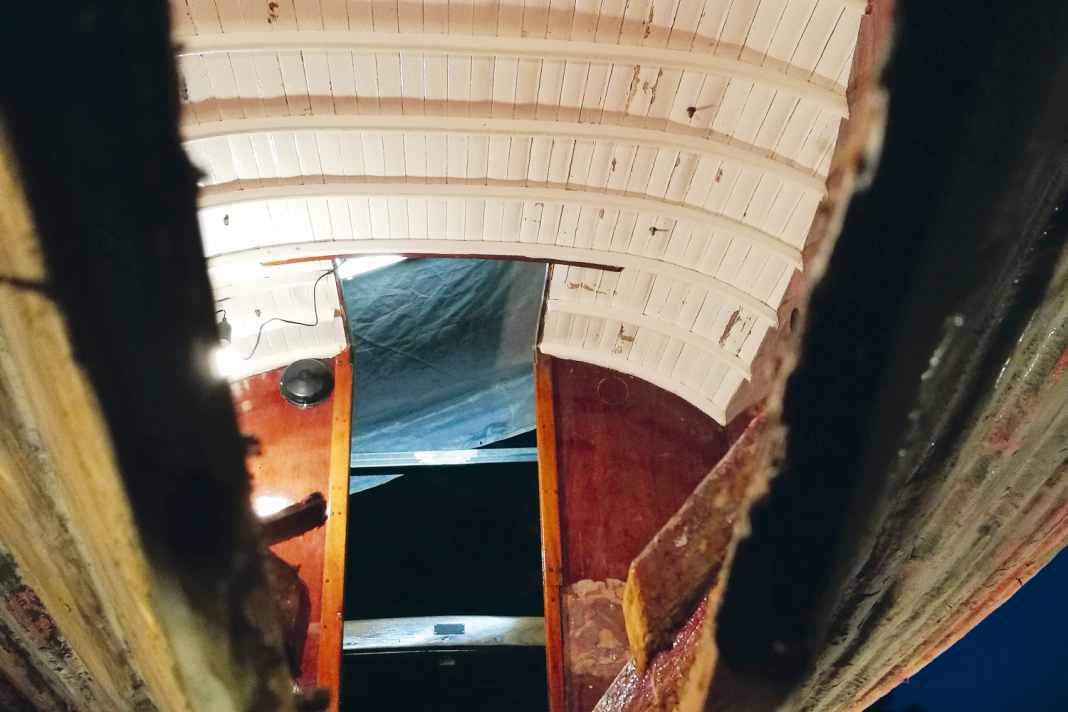





Some people have called me crazy," says Vincent Regenhardt. He is sitting in the cockpit of his Nordic folk boat "Saga" on the Flensburg Fjord on a sunny September day. The waves sound brightly on the clinkered larch wood hull, mahogany gleams in the sun. Sitting comfortably on the aft deck, the tiller lies lightly in the hand in gusty winds of four to six metres. Occasionally, the agile wooden boat tilts in a gust. Then Vincent's face shines brightly above the red sea rescue T-shirt with his boat.
It took the young engineer three years, 5,000 hours of work and overcoming a deep-seated fear to restore it to its former condition. Today, there is nothing to suggest that the 1951 Folkboat almost disappeared forever at the bottom of the fjord five years ago - and that we are actually sitting on not one, but two Folkboats.
Folkboat "Saga" no longer appears to be salvageable
10 September 2017 is as sunny as today, just a little cooler. Wind force four, gusting to six. "Sporty sailing weather, but as a folkboat sailor, there was nothing to complain about," recalls Regenhardt of the trip to the folkboat meeting in Fahrensodde, for which he took two fellow sailors on board. As the boat leans to one side in a gust, a relaxed ten degrees, an unspectacular 20 and finally 30 accompanied by a loud "Jo!", the skipper luffs up, puts slack in the sheets - but nothing happens. In slow motion, "Saga" lays on its side until the water comes in over the port coaming.
The sailors jump off the boat. Regenhardt is standing in the cabin entrance when several hundred litres of water slosh into the boat. Only when the water level inside and outside has reached the same level can he swim out. He scrapes his shin somewhere on the hull. The sailors swim to recover the sails and right the boat in dinghy style with the help of another ship. Regenhardt climbs on board. But on deck, he only has to take a tiny step to the side to capsize "Saga" again.
Also interesting:
This is no longer the faithful Folkboat that his short legs first stepped on when he was four years old. Which, after an extensive first refit in 1992, carried the whole family on summer holidays in the Danish South Seas without a hitch. On which Regenhardt and his brother learnt to sail, from whose deck they jumped into the clear Baltic Sea off Lyø and in whose cabin they snuggled up with their parents and a Labrador in the evenings. Regenhardt had never before had cause to doubt the reliability and seaworthiness of his folk boat, but now his confidence is wavering and waning with every centimetre that "Saga" lays on its side.
He gives them up. Hypothermic, soaked and happy about their rescue, the three sailors find themselves in hospital in Kollund, Denmark. Regenhardt's head is buzzing with questions and memories: "Why did 'Saga' capsize? What will happen without her? How do I tell my father?" Year after year, he travelled with his family, and later on his own, from the small village of Westen in the district of Verden in deep Lower Saxony to Flensburg. The far north is his home, a "Moin" is his greeting, and he prefers to sit in the cockpit in the evening than in a cool club.
After training as a mechatronics engineer in Hanover, he has just secured his dream university place in Flensburg. Vincent, "Saga" and his old Harley-Davidson at his dream home: everything is perfect - and now his "Saga" is leaving him.
The rescue - but without a keel
Or so he thinks. In fact, the German sea rescuers take the shipwrecked vessel on the hook and also tow it to Kollund, just as the wake of the fire brigade rib with the rescued people has disappeared into the expanse of the fjord. There, a German folkboat sailor takes on the "Saga" and organises a tow to Fahrensodde, where the harbour master is already waiting with a crane, belts and storage trestle. Regenhardt only learns of this when a friend picks him and his fellow sailors up from hospital. The ship that was thought lost is saved, but not quite. A tonne of iron ballast has remained at the bottom of the fjord.
"But giving it up was not an option. Saga' is the reason why I came to the coast and wanted to stay here. She harbours the memories of my entire childhood and youth. I didn't want any other boat," says Regenhardt, describing his emotions, because he and his father Uwe, who had travelled here from Lower Saxony, were not just applying rational standards when they stood in front of the trestle, looked at the boat with the strange keel shape and discussed what to do. He is deeply convinced that the boat is in very good condition for restoration.
The work is to be carried out gradually. On his father's farm in Lower Saxony, which will become a shipyard for a long time to come. For Vincent, this means that after just a few weeks of finally being in one place with his boat, he is now travelling in the opposite direction again whenever he has time to work on "Saga". Summer and winter on his old Harley, which will have 25,000 kilometres more on the clock after the restoration.
Second Folkeboot as spare parts donor
His idea sounds simple: "I'll find a donor ballast, maybe one or two other parts and rebuild her by making one out of two Folkboats." Father and son eventually buy a complete Folkboat that is no longer sailable and call it a "parts carrier". A matter-of-fact term that prevents emotional inhibition when it comes to dismantling the boat for recycling.
There are no instructions for what they are planning to do. And when "Saga" has been stripped of its inner workings, there is still a lot of damage. Corroded steel, crumbling wood. In addition, a wide gap on the port side, held shut for decades by a black mass of an unknown nature. Discoveries that remind the young skipper that he still has to regain his childhood confidence in the "Saga".
This is only possible with a project focussed uncompromisingly on safety and stability, which leaves nothing out, from the woodwork to the gas pipes to the electricity - without compromising the beauty of this little classic. Not a single piece of rusty steel remains in the ship, and every metre of wood is subjected to a thorough inspection and replaced where necessary. The simple idea of fitting parts of one Folke boat into the other turns out to be a complex puzzle that requires constant balancing and adjustment. Once all the parts are back in place, Regenhardt applies large fabric mats with epoxy to the outside of the clinkered hull. "It's an experiment, but so far it's working." In fact, after three years, the wood in the open boat shows no signs of discolouration that would indicate that it could decompose in its hull.
For about two years, he collects all the wood that is suitable for a Folk boat: Okumé and mahogany plywood, solid mahogany and teak. You can see him working on the "Saga" alone or with his father in YouTube videos. And the likeable young man finds a lot of support from the community of folkboat sailors - the refit is also becoming a socially heart-warming project, and some people are happy to be able to do their bit.
Launch 2.0
But as much as Regenhardt suffered during the restoration, today the focus on board is on enjoyment and aesthetics. Between teak and solid wood mahogany, he draws drinking water from a tank welded to fit the polyethylene bilge at the small sink and brews freshly ground coffee.
Next to it lies a cake baked in the camping oven in the morning on silky matt wood: the "make two into one" method left an abundance of precious wood for a lavish interior design. There is room for several pans in the cupboard under the two-burner hob, with a small collection of spices above. Between the saloon benches, a roll-up bed frame and additional cushions turn the narrow sleeping areas into a comfortable sunbathing area.
Everything official, nothing dilapidated. Nevertheless, as "Saga" swings gently in her box after our merry dash across the fjord, her owner recalls: "I was never more nervous than on the day in August 2020 when 'Saga' came back into the water for her launch 2.0. I climbed down the ladder in the crane basin and hesitated before I could take the first step onto the boat. I knew that she couldn't and wouldn't tip over - but the unsure feeling was still there."
Regenhardt can only finally jump out of this shadow when he sails out single-handed in 2021 on a day with similar conditions to the day of the capsize. The fear gives way to joy and pride in what he has achieved, freeing the way for some great sailing and perhaps completely new sailing plans. They don't have to be big for Vincent, he loves the variety of sailing, anchoring and swimming. He likes discovering small harbours and the islands behind them, especially in Denmark.
He only describes this briefly before quickly returning to what is on his mind while sailing on his "Saga": the bilges could be laid out a little more practically, the - incidentally - impeccably shiny floor in the cabin is more than 70 years old and could be replaced, a new cool box needs to be accommodated and the bunk needs to be modified.
He calls them small details, "the last five per cent" - five per cent that are based on a conceivably high basic value and are intended to make the ship even more perfect.
No half measures






After the loss of the ballast keel, "Saga" is completely gutted. It turns out that not only the keel bolts are rusted. Tannic acid, particularly from the oak wood, has attacked the steel everywhere and its corrosion has in turn corroded the wood. Traces of rust point the way to the damage. The keel beams, stem, frames and also the floor frames are partially rotten. There is a crack in the hull between the larch planks. The spare part foiling boat has a slightly different shape - with major consequences: In the underwater area, the spars and landings do not fit at almost any point; all the planks have to be glued together. The stem of the donor boat has to be scaffolded and the sternpost built from scratch. More than half of the total length of the frames also had to be replaced.
Technical data of the Folkeboot "Saga"
- Building yard: Børresen
- Year of construction: 1951
- Purchase/refit: 1992
- General average: 2017
- Restoration: 3 years
- Working hours: 5,000 hours
- Costs: 12,500 euros
- Home harbour: Wackerballig
The article first appeared in YACHT Classic 2/2024 and has been updated for the online version.

